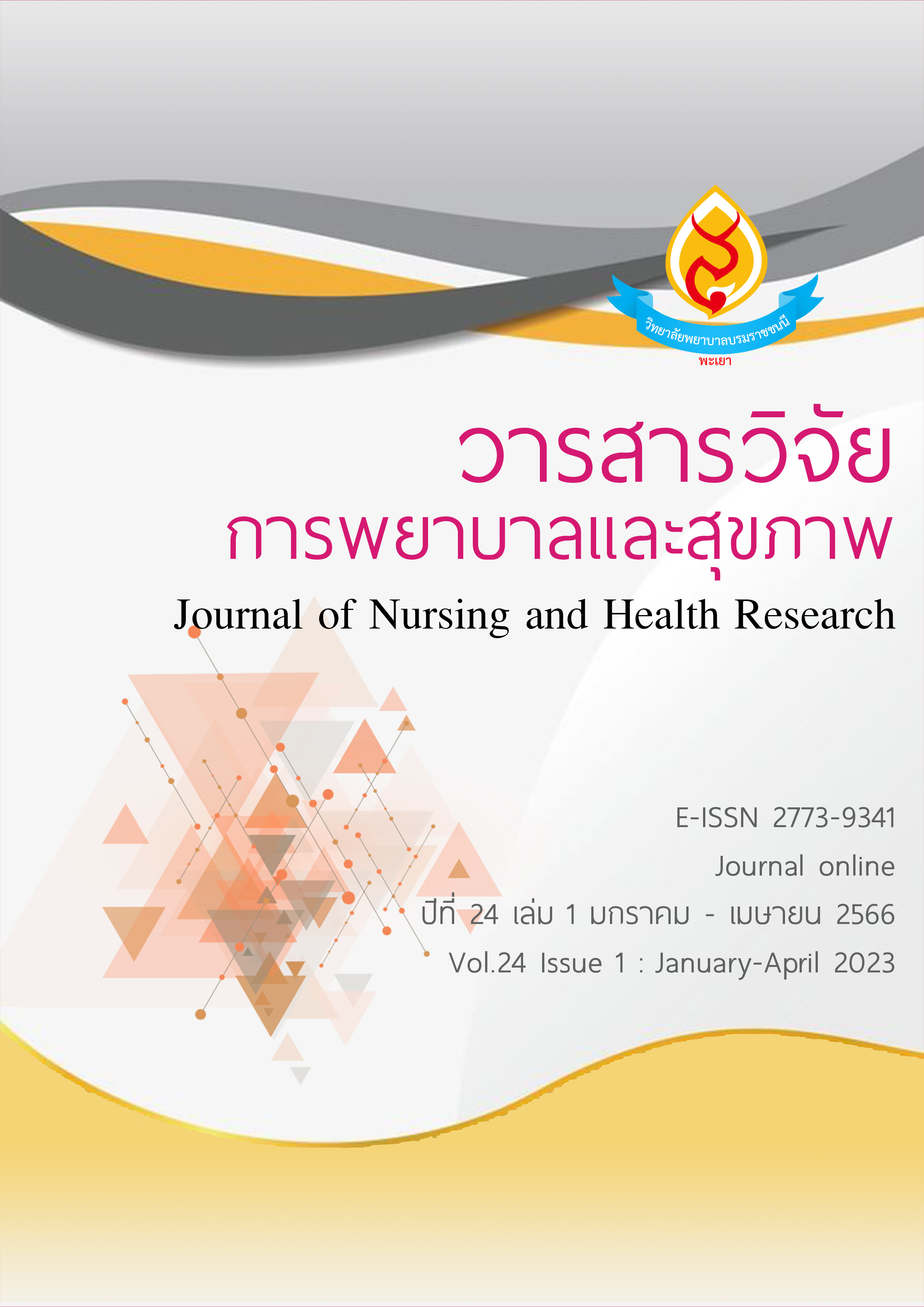ผลของการเยี่ยมบ้านภายใต้ทฤษฎีการมีส่วนร่วมของชุมชนต่อคุณภาพชีวิตและความสามารถ ในการทำกิจวัตรประจำวันของผู้สูงอายุติดบ้าน ติดเตียง ตำบลแม่กา อำเภอเมือง จังหวัดพะเยา
คำสำคัญ:
การเยี่ยมบ้าน, ทฤษฎีการมีส่วนร่วมของชุมชน, คุณภาพชีวิต, ความสามารถในการทำกิจวัตรประจำวัน, ผู้สูงอายุติดบ้าน ติดเตียงบทคัดย่อ
ปัจจุบันในสังคมไทยมีจำนวนผู้สูงอายุติดบ้าน ติดเตียงเพิ่มขึ้นทำให้ความต้องการในการดูแลผู้สูงอายุกลุ่มนี้เพิ่มสูงขึ้นตาม โดยเฉพาะการดูแลผู้สูงอายุที่อาศัยในชุมชน การวิจัยกึ่งทดลองครั้งนี้มีวัตถุประสงค์เพื่อศึกษาผลของการเยี่ยมบ้านภายใต้ทฤษฎีการมีส่วนร่วมของชุมชนต่อคุณภาพชีวิตและความสามารถในการทำกิจวัตรประจำวันของผู้สูงอายุกลุ่มติดบ้าน ติดเตียง กลุ่มตัวอย่างกลุ่มทดลองเป็นผู้สูงอายุติดบ้าน ติดเตียง ตำบลแม่กา อำเภอเมือง จังหวัดพะเยา จำนวน 30 คน ที่ได้รับการเยี่ยมบ้านภายใต้ทฤษฎีการมีส่วนร่วมของชุมชน กลุ่มควบคุมเป็นผู้สูงอายุติดบ้าน ติดเตียงในต่างพื้นที่ ที่ได้รับการเยี่ยมบ้านตามปกติ จำนวน 30 คน โดยมีการประเมินก่อนการศึกษาและหลังการศึกษา 6 เดือน เครื่องมือที่ใช้ในการวิจัย ประกอบด้วย โปรแกรมการเยี่ยมบ้านภายใต้ทฤษฎีการมีส่วนร่วมของชุมชน แบบประเมินคุณภาพชีวิตขององค์การอนามัยโลกชุดย่อฉบับภาษาไทย และแบบประเมินความสามารถในการดำเนินชีวิตประจำวันดัชนีบาร์เธลเอดีแอล วิเคราะห์ข้อมูลด้วย ค่าเฉลี่ย ร้อยละ ส่วนเบี่ยงเบนมาตรฐาน สถิติที การทดสอบแมน-วิทนีย์ยู และการทดสอบ วิลคอกซัน ผลการวิจัย พบว่า คุณภาพชีวิตและความสามารถในการทำกิจวัตรประจำวันของผู้สูงอายุกลุ่มติดบ้าน ติดเตียง หลังการเยี่ยมบ้านของกลุ่มทดลองดีกว่าก่อนการเยี่ยมบ้านอย่างมีนัยสำคัญทางสถิติ (p<.001) คุณภาพชีวิตและความสามารถในการทำกิจวัตรประจำวันของผู้สูงอายุกลุ่มติดบ้าน
ติดเตียงภายหลังการศึกษาของกลุ่มทดลองดีกว่ากลุ่มควบคุม อย่างมีนัยสำคัญทางสถิติ (p<.001) การเยี่ยมบ้านผู้สูงอายุกลุ่มติดบ้าน ติดเตียงภายใต้ทฤษฎีการมีส่วนร่วมของชุมชนสามารถช่วยยกระดับคุณภาพชีวิตและความสามารถในการปฏิบัติกิจวัตรประจำวันของผู้สูงอายุที่มีภาวะพึ่งพิงในชุมชนได้
เอกสารอ้างอิง
กุลธิดา กุลประฑีปัญญา, วิรดา อัศวเมธากุล, ปรางทิพย์ ทาเสนาะ เอลเทอร์, จามจุรี แซ่หลู่, เพ็ญนภา พิสัยพันธุ์, และ อรัญญา นามวงศ์. (2563). สถานการณ์ภาวะสุขภาพของผู้สูงอายุในสังคมไทย. วารสารวิชาการมหาวิทยาลัยการจัดการและเทคโนโลยีอีสเทิร์น, 17(2), 581-595.
เกศิณี วงศ์สุบิน. (2560). ประสิทธิผลของโปรแกรมการเสริมสร้างพลังอำนาจเพื่อลดความเสี่ยงต่อการป่วยเป็นโรคเบาหวานในประชาชนกลุ่มเสี่ยง อำเภอโป่งน้ำร้อน จังหวัดจันทบุรี (วิทยานิพนธ์ปริญญาวิทยาศาสตรมหาบัณฑิต). กรุงเทพฯ: มหาวิทยาลัยมหิดล.
จุฑาทิพย์ งอยจันทร์ศรี และ อรสา กงตาล. (2555). การพัฒนาการดูแลสุขภาพอย่างต่อเนื่องสำหรับผู้สูงอายุกลุ่มติดบ้าน ติดเตียงในชุมชนเขตเทศบาลเมืองเพชรบูรณ์. การประชุมเสนอผลงาน วิจัยระดับบัณฑิตศึกษา. มหาวิทยาลัยขอนแก่น.
พิศสมัย บุญเลิศ, เทอดศักดิ์ พรหมอารักษ์, และศุภวดี แถวเพีย. (2559). การพัฒนารูปแบบการดูแลสุขภาพอย่างต่อเนื่องสำหรับผู้สูงอายุกลุ่มติดบ้าน ติดเตียงในโรงพยาบาลส่งเสริมสุขภาพตำบลดงมัน ตำบลสิงห์โคก อำเภอเกษตรวิสัย จังหวัดร้อยเอ็ด. วารสารสำนักงานป้องกันโรคที่ 7 จังหวัดขอนแก่น. 23(2), 79-87.
เพ็ญนภา มะหะหมัด. (2561). รูปแบบการจัดบริการการดูแลสุขภาพกลุ่มผู้สูงอายุติดเตียงโดยการมีส่วนร่วมของชุมชน ตำบลสุไหงโกลก จังหวัดนราธิวาส. วารสารมหาวิทยาลัยนราธิวาสราชนครินทร์, 10(2), 51-63.
มูลนิธิสถาบันวิจัยและพัฒนาผู้สูงอายุไทย. (2564). สถานการณ์ผู้สูงอายุไทย พ.ศ. 2563. นครปฐม: สถาบันวิจัยประชากรและสังคม มหาวิทยาลัยมหิดล.
สุวัฒน์ มหัตนิรันดร์กุล, วิระวรรณ ตันติพิวัฒนสกุล และ วนิดา พุ่มไพศาลชัย. (2540). เปรียบเทียบแบบวัดคุณภาพชีวิตขององค์การอนามัยโลกทุก 100 ตัวชี้วัด และ 26 ตัวชี้วัด, เชียงใหม่: โรงพยาบาลสวนปรุง.
สำนักงานสถิติแห่งชาติ. (2565). การสํารวจประชากรสูงอายุในประเทศไทย พ.ศ. 2564. จาก http://www.nso.go.th/sites/2014en/Survey/social/domographic/OlderPersons/2021/fullreport_64.pdf
อมรรัตน์ ปะติเก, ชนัตถา พลอยเลื่อมแสง, จันทร์ทิพย์ กาญจนศิลป์, และ ศิรินาถ ตงศิริ. (2562). ผลของการดูแลที่บ้านโดยทีมสหสาขาวิชาชีพต่อคุณภาพชีวิตของผู้สูงอายุที่ติดบ้านและติดเตียง. วารสารเภสัชกรรมไทย, 11(4), 860-868.
Cohen, J. & Uphoff, N. (1980). Participation's place in rural development: seeking clarity through specificity. World Development. 8. 213-235. doi:10.1016/0305-750X(80)90011-X.
Jitapunkul, S., Kamolrattnankul, P., Clulndraprasert, S., & Bunnag, S. (1994). Disability among the elderly living in Klong Toey Slum. Journal of the Medical Association of Thailand, 77, 231-8.
World Health Organization. (2002). Community participation in local health and sustainable de-velopment: approaches and techniques. World Health Organization.
ดาวน์โหลด
เผยแพร่แล้ว
รูปแบบการอ้างอิง
ฉบับ
ประเภทบทความ
สัญญาอนุญาต
ลิขสิทธิ์ (c) 2023 วารสารวิจัยการพยาบาลและสุขภาพ

อนุญาตภายใต้เงื่อนไข Creative Commons Attribution-NonCommercial-NoDerivatives 4.0 International License.



